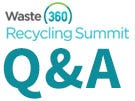Recycling Experts Answer Your Questions About Contamination, Optimizing Materials
 This is the fifth part of a series that provide answers by industry experts to questions you have about recycling. The questions came out of Waste360’s recent webinar on the cost of recycling. For further discussion on these issues, don’t miss the Waste360 Recycling Summit in Chicago later this year.
This is the fifth part of a series that provide answers by industry experts to questions you have about recycling. The questions came out of Waste360’s recent webinar on the cost of recycling. For further discussion on these issues, don’t miss the Waste360 Recycling Summit in Chicago later this year.
Read part one here; part two here; part three here; part four here.
Question: Are there some substantial advantages of keeping glass and paper out of waste stream and introducing a resource bin/can?
Bruce Walker, solid waste & recycling program manager, city of Portland, Ore.: Yes. Keeping glass separate from other recyclables substantially increases the marketability of glass, reduces cross-contamination of broken glass in paper and decreases MRF residue. Our program in Portland collects paper, plastic and metal in a roll cart with glass kept separate in a bin. This requires our haulers to keep a separate compartment on their recycling trucks, which adds costs but we believe is much more beneficial than mixing glass with other materials.
Question: What is the best practice you have seen or heard about in regards to getting generators to clean up the inbound material?
Greg Superneau, education & outreach coordinator, city of Springfield, Mass.: What we have seen in Springfield is that tagging (not fining) and leaving behind contaminated carts is the most effective way to clean up our single stream. There has to be a system in place to track carts that are left behind and to inform residents of what in their cart caused it to not be picked up. I will outline how the city implemented this process and how we were able to quickly mitigate the contamination problem in a matter of weeks in my presentation at the summit.
Karen Bandhauer, project director, Curbside Value Partnership: Education is critical, but where the real improvement happens is when high quality education is paired with operations. This requires a different type of relationship between the city government and the resident. Instead of the “magic curb” effect, where anything placed outside at the start of the day is gone by the end, the community is providing residents with clear, simple, accurate information about how to participate in the recycling program, and that information is being reinforced through feedback at the curb–be it an oops card, a knock on the door, or a cart rejection. When done right, this approach builds trust and buy-in as residents learn that recycling isn’t just another, less guilty, mechanism to send their waste “away” but a system that is important to their community and requires their engagement to make it work well.
Question: How long do you consider a long-term processing contract should be?
Bill Moore, president, Moore & Associates: Ten years.
Question: What is the biggest/most prevalent contaminant that causes/contributes to residue?
Michele Nestor, president, Nestor Resources Inc.: Glass.
Bill Moore: In the paper industry, the two largest contaminant issues are plastic films and glass in recovered paper.
Greg Superneau: Plastic bags. Maybe not as a component when measuring the loads by weight, but plastic bags present two problems. First, they can get wrapped around sorting equipment, driving up costs for the processors. Second, most of the time the bags are filled. Sometimes with recyclable items, other times with garbage or other non-recyclable items. We have seen full black-and-white garbage bags, whose contents cannot be clearly seen, in recycling barrels.
About the Author
You May Also Like


.png?width=300&auto=webp&quality=80&disable=upscale)